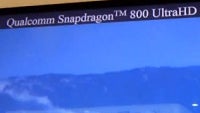Take a look at Qualcomm’s Snapdragon 800 handling of 4K video over LTE Advanced

One of the challenges confronting not only customers, but carriers and manufacturers is media content. It seems that with every leap forward that opens up the pipeline of greater throughput of data transfer rates, the richer content ecosystem finds a way to fill the available spectrum with heavier traffic.
Every year, we learn about new advances in audio, photo and video content as well as hardware that can deliver stunning sights and sounds in the process. Bringing these elements together is connectivity that is increasingly wireless in nature.
Bandwidth and throughput on wireless standards is also advancing, but challenges in spectrum capacity and efficiency in using that spectrum is an area that providers and manufacturers are contending with. Qualcomm is at the center of this challenge as the world leader in central processing units for smartphones.
The Snapdragon 800 processor is at work in a new generation of hardware like the LG G2, Nokia Lumia 1520 and Lumia 2520 tablet. The CPU is at the heart of delivering swift and smooth performance across platforms and Qualcomm was showing off that there is more to come from this newest family of chipsets.
The video is difficult to visualize at first as ambient lighting posed a challenge, and obviously taking a video recording of a video recording is often an exercise in futility. However, if you look closely and listen to our conversation with Qualcomm you will see what is coming to bear as carriers develop their networks.
Qualcomm is showcasing the Snapdragon 800 processing 4K UltraHD video over two different types of connections, LTE as it is essentially available today in the US and LTE-Advanced. For the LTE only connection, the video was delivered at a rate of roughly 7.5Mbps. On the LTE-A stream, that data rate is doubled to 15Mbps.
Taking aside the data rates each of these standards are theoretically capable of supporting (up to and beyond 100Mbps), this display is shows a distinct difference in how video content will look on a finished product. Qualcomm was using new Sony Bravia 4K TV panels. The improvement from LTE to LTE-A is telling, but even more dramatic is how the Snapdragon 800 CPU is able to manage the load without skipping beat.

Bandwidth and throughput on wireless standards is also advancing, but challenges in spectrum capacity and efficiency in using that spectrum is an area that providers and manufacturers are contending with. Qualcomm is at the center of this challenge as the world leader in central processing units for smartphones.
The video is difficult to visualize at first as ambient lighting posed a challenge, and obviously taking a video recording of a video recording is often an exercise in futility. However, if you look closely and listen to our conversation with Qualcomm you will see what is coming to bear as carriers develop their networks.
Taking aside the data rates each of these standards are theoretically capable of supporting (up to and beyond 100Mbps), this display is shows a distinct difference in how video content will look on a finished product. Qualcomm was using new Sony Bravia 4K TV panels. The improvement from LTE to LTE-A is telling, but even more dramatic is how the Snapdragon 800 CPU is able to manage the load without skipping beat.

Follow us on Google News













Things that are NOT allowed:
To help keep our community safe and free from spam, we apply temporary limits to newly created accounts: